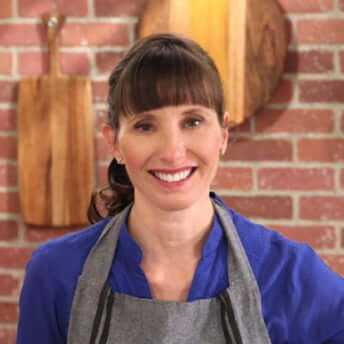Listen to This Article:
When most of us think of birthday, graduation, or wedding cakes, we think of sheet cakes, or stacked round cakes with buttercream frosting.
But the world of high-end cakes is filled with stunning examples of exquisitely decorated pastry masterpieces that appear to have fabric draped over them, or hyper-realistic cakes made to look like ceramic vases or easy chairs, as featured on the baking game show Is It Cake.
Fondant—a moldable or pourable type of icing—is what makes these amazing cakes possible. So what is this mystery frosting that allows cakes to appear magical, realistic, or chic? And how can you approach it if you’re just starting out? Let’s explore the world of fondant.
What Is Fondant?
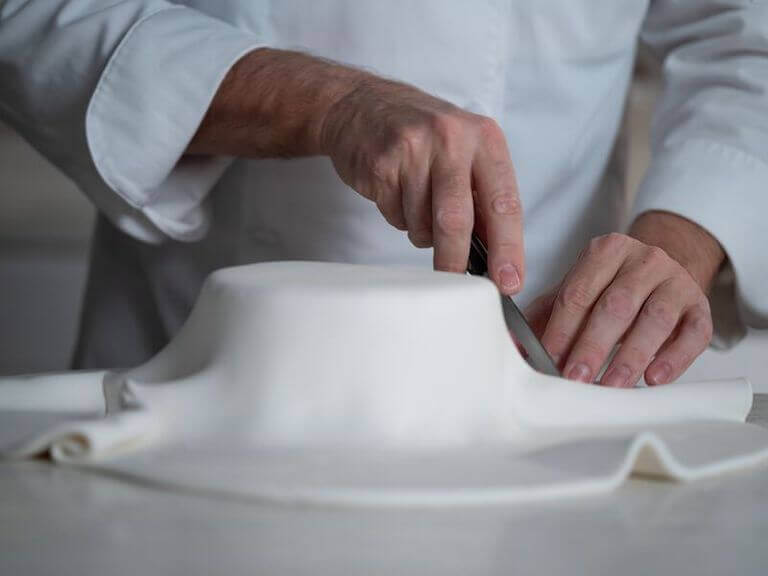
Rolled fondant is draped over a cake to seal and decorate it. Fondant can be white or tinted with food dye and flavored however you like.
There are multiple types of fondant, each used for different tasks in the bakery. Fondant is essentially a pliable, rollable icing made with sugar, water, corn syrup, and gelatin. The term “fondant” comes from the French word “fondre” which means “to melt”. It shares a root with the word fondue, the melted cheese sauce for dipping.
Fondant has been used in cake decorating for centuries but currently is most commonly used in wedding and high-end birthday cakes.
What Are the Uses of Fondant?
The elegant smoothness of rolled fondant lends itself to the simplest use: as a cover around an entire cake.
The matte finish is a clean, blank slate for a wide variety of decorations: molded figures, flowers, or shapes, decorative royal icing, relief carving, and more.
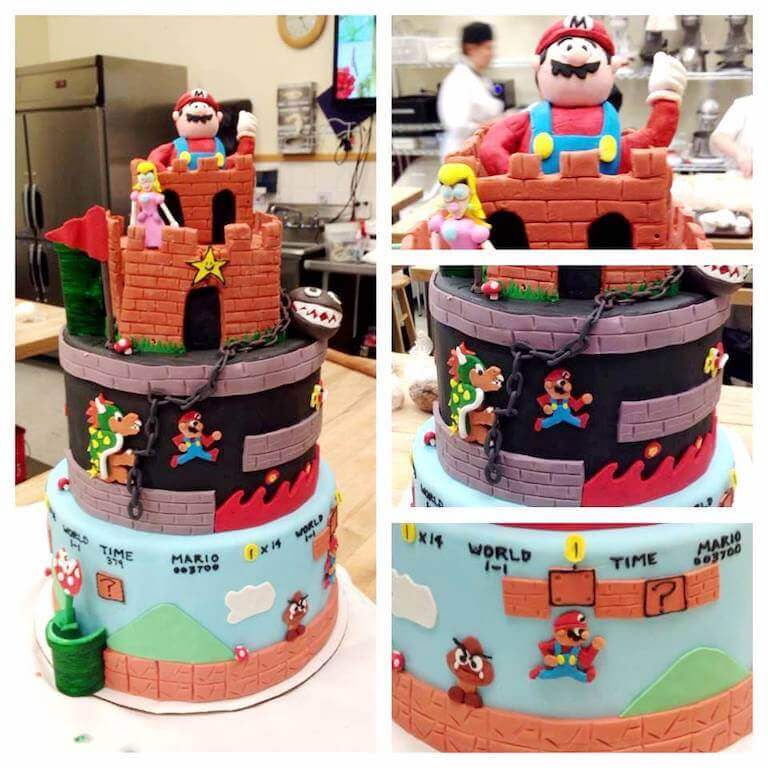
Fondant can be used to create whimsical scenes, shapes, and characters on cakes for birthdays, weddings, or any special occasion.
Because fondant can be tinted to any desired color and flavored as desired, it can enhance any cake design for fun or style. Fondant can also be used as an edible modeling clay to create anything you imagine, from dragons and cars to flowers and musical instruments. Pourable fondant can be used to glaze or ice cakes, cookies, cupcakes, and other confections, or as fillings for other kinds of bakery treats, like bonbons or truffles.
Types of Fondant
Pastry artists use several types of fondant to enhance their creations. The main difference between them is their stiffness, which is created by small variations in the recipes.
Rolled Fondant
Bakeries most commonly use rolled fondant. Sugar, water, corn syrup, and gelatin are mixed and heated to just the right temperature. This type of fondant is rolled out flat in sheets then draped over an entire cake or used for making other types of designs, such as flat stars, ribbons, flowers, or hearts.
You can make fondant in your own kitchen fairly easily, or buy pre-made sheets. Rolled fondant helps seal a cake, which can help it last a little bit longer. Pre-made fondant may have longer working time, but you’ll have less control over the color and flavor than if you make your own.
Poured Fondant
Poured fondant is a mixture of melted sugar dissolved in water that is poured over cakes, cupcakes, or petit fours. Once in place, it hardens to create a smooth, matte or glossy finish. To create poured fondant, you mix sugar, corn syrup, and water until the sugar melts. You must use a candy thermometer to make sure the mixture stays below 100°F. Once the sugar is melted, you place your cake, cupcake, or other confection on a cooling rack with a tray underneath, and pour the fondant. This creates a perfectly smooth, professional-looking glaze on your cakes, and if flavored well, it’s delicious too.
Sculpting Fondant
Sculpting fondant is similar to rolled fondant, but the recipe is altered to make it more firm. This added firmness allows you to shape or mold it into figures or 3D shapes.
How to Make Rolled Marshmallow Fondant
When confronted with this strange, smooth cake covering, people often wonder what fondant is made of. There are many fondant recipes, but most share a basic collection of ingredients: confectioners’ (powdered) sugar or icing sugar, liquid (usually water, milk, or heavy cream), corn or glucose syrup, gelatin for elasticity, and glycerin to keep the fondant soft, plus flavorings.
The most common homemade fondant uses marshmallows instead of forcing you to go out and buy specialty ingredients; marshmallows already contain things like glycerin and gelatin.
Here is a basic Marshmallow Fondant recipe:
- 1 pound confectioners’ or icing sugar
- 8 oz. miniature marshmallows
- 2 Tbsp. water
- Food coloring (optional)
- Flavor extracts (optional)
Some helpful tools:
- Large mixing bowl
- Bowl scraper
- Strainer or sifter (for powdered sugar)
- Extra powdered sugar
- Small container of vegetable shortening
The vegetable shortening can help offset the stickiness that the marshmallows typically produce. You can also add some more sifted powdered sugar, 1/4-cup at a time, to your mixture to reduce stickiness.
Instructions:
- Microwave the marshmallows in a microwave-safe bowl for 30-45 seconds, until puffy.
- Stir with a rubber spatula until smooth and liquid.
- Add optional food coloring and flavoring, if desired.
- Begin adding confectioners’ sugar until you can no longer stir.
- Dust a flat surface and your hands with confectioners’ sugar and knead the mixture. Continue incorporating the confectioners’ sugar until it’s smooth and flexible.
- Roll out or shape how you’d like!
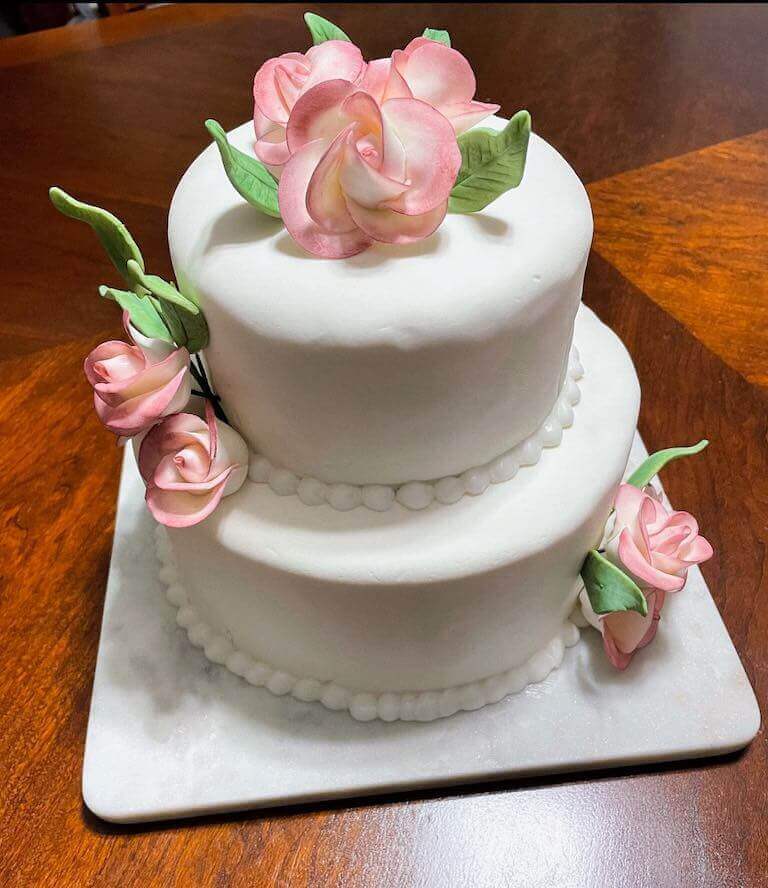
A fondant-covered cake with sculpted fondant flowers by Escoffier Online Baking & Pastry Graduate Christina Osorio.
What Does Fondant Taste Like?
A lot of people complain that fondant either doesn’t taste like much, or is kind of gross. Some people even wonder, “Is fondant edible?” the first time they encounter it. It may not be for everyone. But the short answer is that it tastes like whatever you decide to flavor it with.
Fondant is a very basic recipe made with sugar, corn syrup, and water, and the sky is the limit when it comes to flavor. Just about any flavor that blends well with your cake and filling is appropriate.
The majority of fondant is likely one of the three traditional flavors: vanilla, chocolate, and almond. These basics blend well with white, yellow, or chocolate cakes and a variety of buttercream fillings. But some bakers are experimenting with some more unusual fondant flavors. Why not try lemon fondant on an orange-flavored cake, or raspberry fondant on a pistachio cake. Or coffee or maple?
You could even have some fun with seasonal flavors like pumpkin spice or peppermint during the winter holidays. The bottom line is that fondant provides another way to blend unique flavors to enchant your customers’ taste buds and explore your creativity. So have fun!
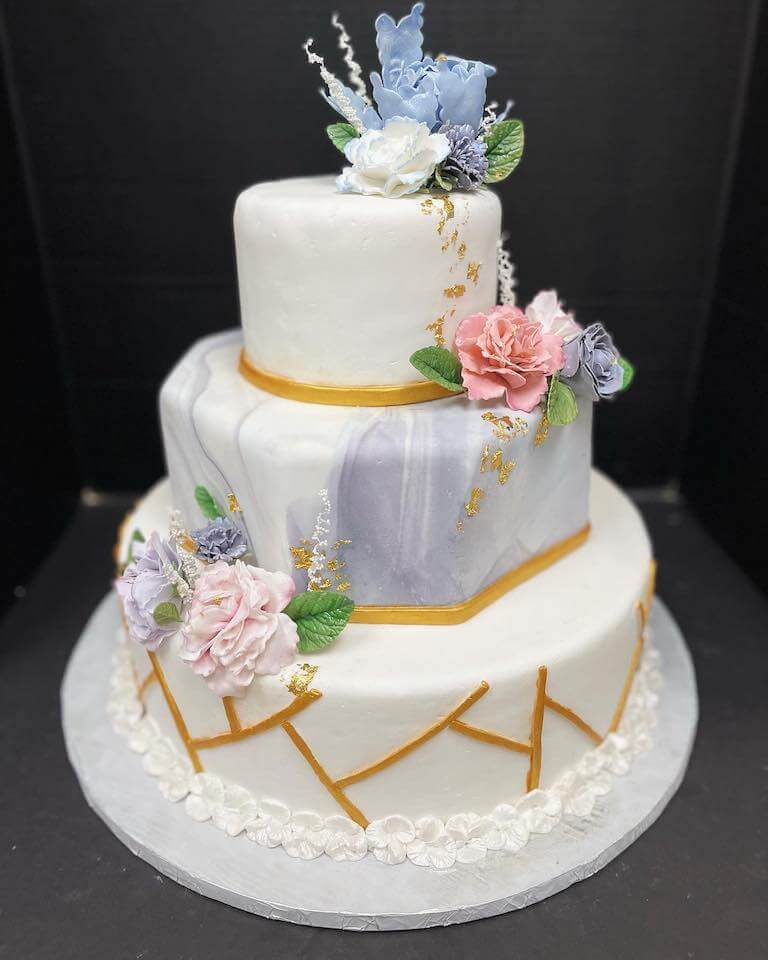
Fondant can be plain or elaborately flavored and colored, like this example made by students at Escoffier’s Austin campus.
Tips for Best Results When Working With Fondant
Though fondant makes a beautiful, smooth, and even covering for cakes, it can be a little tricky to work with, especially the first few times you try. Here are a few tips to make sure your fondant layer turns out just how you want it.
Prepare Your Work Surface
You will need to roll your fondant out before transferring it onto your cake. Make sure your work surface is completely clean and dry before you start. Any cake crumbs, bits of sugar, or moisture can affect the quality of your finished product, so be diligent. You’ll also want to gather your materials: rolling pin, cornstarch and powdered sugar for dusting, cutting tools, and a cake smoother, if you’ll be using one.
Prepare Your Fondant Properly
If you’ll be adding food coloring to your fondant, do so a day or two ahead of time so it has a chance to settle fully. Bring your fondant to room temperature before working it, and thoroughly knead it before rolling. This helps prevent cracking and tearing when you roll it out.
Roll the Fondant on a Dusted Surface
Sprinkle a blend of powdered sugar and cornstarch on your rolling surface before beginning, unless it’s very humid. In this case, it’s best to use cornstarch only. Roll out your fondant a little larger than needed, and use your rolling pin to move it to your cake.
Smoothing, Shaping, and Cutting Fondant
Once you have your rolled fondant draped on your cake, your warm hands are generally the best smoothing and shaping tool. You can also try a cake smoothing tool, which kind of looks like an iron. A sharp kitchen knife or Exacto knife are great tools for cutting fondant. A pizza wheel can also be used.
Common Fondant Pitfalls and How to Fix Them
What if your fondant tears after you’ve applied it to your cake, looks lumpy, or develops air bubbles? Prevention is worth a pound of cure. Rolling your fondant to just the right thickness can prevent tears. But if your fondant does happen to tear, you can usually use your fingers moistened with a little shortening to smooth over the tear. If the tear is significant, either remove the whole piece and start with fresh fondant, or apply a patch of fondant and smooth it with your fingers. Don’t reuse previously used fondant as it will have frosting and crumbs stuck to it and will no longer look clean.
To prevent a lumpy appearance, make sure your cake and icing underlayer is very smooth. Any imperfections in your cake will show up through the fondant, so take extra care when preparing your cake.
Finally, air bubbles do sometimes occur. You can use an acupuncture or sewing needle to puncture the air pocket and gently press the air out and smooth the fondant with your hands.
If you truly can’t fix your blemish, you can cover up any imperfections with a design element, like piped frosting, a piped or real-life flower, or other decoration.
When Should You NOT Use Fondant?
Even though fondant increases your cake decorating toolkit, it’s not always the best option. If cost is one of your concerns, a cake with fondant will likely not be your best option. Any bakery can frost a cake with buttercream, but the ability to use fondant is a specialized skill set and will increase the cost of your cake commission. And if you’re decorating your cake yourself but have never used fondant, there can be a steep learning curve to getting it right.
Fondant is also not the most flavorful option. Many people agree that it tastes awful. To some people, fondant also has a disagreeable texture. So if your guests’ satisfaction is important to you, you might choose a more traditional flavored buttercream or ganache to decorate your cake.
Learn to Make Fondant Like a Pastry Pro
Though fondant may look fancy and out of reach, professional pastry decorating is a learnable skill in culinary school. With the right training and support, you could learn how to create your own creative cakes.
At Auguste Escoffier School of Culinary Arts, a diploma or associate degree in Baking & Pastry Arts can help you develop your skill to become a pastry chef. If pastry arts inspire you, reach out to our Admissions team to learn more about the exciting opportunities available in our online and in-person culinary school options.
IF YOU LIKE THIS ARTICLE ABOUT FONDANT, CONSIDER READING THESE ARTICLES NEXT:
- How to Start a Bakery Business from Home
- How to Become a Pastry Chef
- Do You Need Pastry School to Become a Pastry Chef?
This article was originally published on July 18, 2014 and has since been updated.

